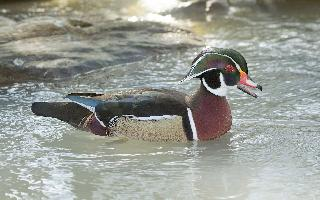
Description de l'animal
The Greater Scaup (Aythya marila), often simply referred to as the scaup, is a mid-sized diving duck that belongs to the family Anatidae. This bird is one of the two species of scaup, the other being the Lesser Scaup (Aythya affinis). The Greater Scaup is a migratory species, breeding in the northern reaches of Europe, Asia, and North America, and wintering further south in coastal bays, estuaries, and open lakes.Physical Description:
The Greater Scaup is characterized by its rounded head and broad, compact body, measuring about 38-56 cm (15-22 in) in length with a wingspan of 70-84 cm (27-33 in). Males are larger than females and have a distinctive appearance during the breeding season. They sport a glossy black head that can appear purple or green in different lights, with a small tuft at the back. Their back is barred with white and black, and they have a bright white underside, with a black tail and vent. The bill is blue-gray with a black tip, earning them the nickname "bluebill" among hunters. Females and non-breeding males are more subdued in color, with brownish bodies and white facial patches, although they retain the characteristic blue-gray bill.
Habitat and Distribution:
Greater Scaups are found in a wide range of aquatic environments. During the breeding season, they prefer shallow freshwater lakes, ponds, and rivers in the tundra and boreal forest regions. In winter, they migrate to coastal areas, favoring sheltered bays, estuaries, and open waters, where they can dive for food. Their wintering grounds extend from coastal Alaska and the northeastern United States down to the Gulf of Mexico and the Mediterranean and Caspian Seas.
Behavior and Diet:
These ducks are highly sociable outside of the breeding season, forming large flocks on wintering grounds. Greater Scaups are diving ducks, plunging below the water's surface to feed. Their diet consists primarily of mollusks, aquatic insects, crustaceans, and small fish, although they will also eat aquatic plants and seeds. They have been observed diving to depths of up to 7 meters (23 ft) in search of food.
Reproduction:
The breeding season begins in late spring when pairs form. Nests are constructed on the ground near water, hidden among vegetation. The female lays a clutch of 6-9 eggs, which she incubates for about 24-28 days. The chicks are precocial, meaning they are relatively mature and mobile from the moment of hatching and are able to feed themselves, although the female provides protection and guidance. The young fledge at about 6-8 weeks of age but may remain with their mother during the first winter migration.
Conservation Status:
The Greater Scaup is currently listed as Least Concern by the International Union for Conservation of Nature (IUCN), indicating it is not currently at immediate risk of widespread decline. However, populations have shown signs of decrease in some areas, attributed to habitat loss, pollution, and possibly climate change affecting their breeding grounds. Conservation efforts are focused on monitoring population trends, protecting critical habitats, and researching the impacts of environmental changes on their breeding success and food availability.
In summary, the Greater Scaup is a fascinating and resilient species, adapting to both freshwater and marine environments across a vast range. Its migration patterns and social behavior, along with its distinctive appearance, make it an interesting subject of study for ornithologists and bird enthusiasts alike.
Animaux similaires
Nouvelles photos d'animaux
Top 10 des animaux
- Dolphin gull (Leucophaeus scoresbii)
- Diana monkey (Cercopithecus diana)
- Moustached guenon (Cercopithecus cephus)
- Galápagos tortoise (Geochelone nigra complex)
- Japanese macaque (Macaca fuscata)
- Stone loach (Barbatula barbatula)
- Russian tortoise (Testudo horsfieldii)
- Greek tortoise (Testudo graeca)
- Common flying dragon (Draco volans)
- Vendace (Coregonus albula)


